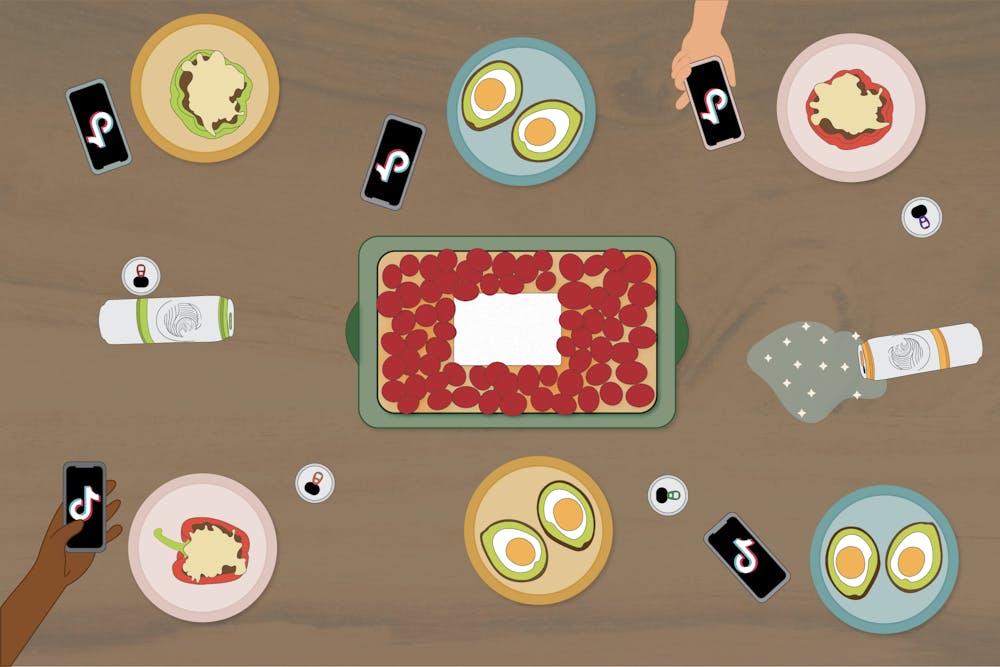From hard seltzers and energy drinks to fad diets and viral recipes, USC students said the last four years saw food trends shaped by TikTok and the pandemic.
These main drivers of change impacted the way college students eat and drink.
Sparkling drinks
It seems like seltzers have been around forever at this point, but White Claws hit it big in 2019 when YouTuber and comedian Trevor Wallace famously said “ain’t no laws when you’re drinking Claws.” The hard seltzer that first launched in 2016 gained over 50% of the market share in 2019.
“They’re a very 'white girl' drink,” third-year public health student, Anaiah Kenas said. “They're low calorie. They’re fruity. They're not very exceptional. There's nothing to them. They're just like a seltzer juice.”
The seltzer category has now become a massive popular market, and now major beer brands like Budweiser are in on the seltzer game. While energy drinks have been popular for a while, new products like Celsius have emerged.
According to second-year sport management student Kate Cazayoux, the energy drink Celsius was all the rage during the fall of 2021.
“During (sorority) recruitment, people would literally fight because Celsius sponsored Pan-Hel recruitment and it was actually like fight to the death for them,” Cazayoux said.
Fad diets
Beyond these bubbly beverages, the other trend that dominated the past few years isn't a food at all, but fad diets.
"Keto," "paleo" and "veganism" have permeated popular discussion of food and nutrition. Their health claims are widely touted, but some are skeptical of their legitimacy.
“I think going too hardcore in any one of those diets is like the dumb thing to do,” third-year finance student, Luke Mullen said. “You shouldn't dive headfirst and like only be a carnivore, 'I'm only gonna eat meat, salt and water.'”
Moderation is the prevailing mood when it comes to diet, but diets like the keto diet also draws anger from some.
“If you know anything about anatomy, you know that the brain functions on glucose, and glucose is a carbohydrate,” Kenas said. “And the entire complex of the keto diet is to not eat carbs. So if you think about it, you're basically starving your brain by doing this diet because you're not giving yourself those complex carbohydrates that your body needs in order to function.”
Pandemic influenced recipes:
While the keto diet may signal an avoidance of carbs, nationwide shutdowns due to COVID-19 brought many into the kitchen to bake. Cazayoux took part in the bread baking resurgence (craze) that occurred amid the pandemic.
“I feel like (baking bread) also became a thing during COVID because people were kind of home they had the time to do it because it is a time-consuming process,” Cazayoux said. “I remember wanting to do it and go into the grocery store not being able to find yeast.”
Cazayoux was able to satisfy her urge to bake bread by making cinnamon rolls from scratch.
In this sense, carbs also converged with popular TikTok trends in the past few years, especially during the pandemic.
Another example is the viral baked tomato and feta pasta recipe that dominated many's TikTok “for you page” at the beginning of 2021. Kenas took part in the trend, while Cazayoux made a version with goat cheese.
Both TikTok and Instagram helped to elevate the status of food influencers. Food content is more accessible than ever on the two platforms and creators like Emily Mariko, a TikTok content-creator known for making healthy rice bowls, have major sway over the eating habits of their followers.
Increasing food access awareness:
Social media influencers have also made strides in the realm of eating disorder awareness through the creation of accessible content.
“There's definitely been a trend of like, 'let me show you what I'm eating,'” Kenas said. “So, what I eat in a day videos have become huge, where people are showcasing (what they eat).”
Kenas thinks that “Eat with Me” videos may help people who have eating disorders have an easier time eating as the videos make eating a communal experience — on demand.
“A couple of my friends have (had eating disorders), and something that I've come across in conversations with a couple of them is that eating with people makes it easier,” Kenas said.
Videos are just one-way healthy eating is being made more accessible. It is now easier to purchase healthy, quality foods thanks to growing organic sections at stores.
“One of the hardest things about being healthy and eating healthy is how much it really costs,” Mullen said. “And just also the availability to people. Is it even in your store, you have to drive 20 miles to go get it?”
Mullen thinks that the expansion of organic sections at stores like Food Lion and decreasing costs of organic foods have made them more accessible. He said the price of organic produce is not that much more than the price of conventional produce.
Access to food on campus has also been addressed in the past year on campus. The addition of Fresh Greene’s in Russell House helps alleviate the burden of food access while in the most central parts of campus.
Fresh Greene's is an all-you-care-to-eat dining location in the spaces that formerly housed Preston's in Russell House. It opened with its new name in the fall of 2021.
“We didn't have a buffet-style dining option in Russell that was accessible to all students up until last year,” Kenas said. “So you were forcing students to eat fast food a lot of the time, and those portion size sizes were often pretty small, especially if you have students with limited dietary restrictions.”

